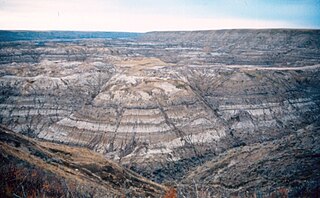In chronostratigraphy, a stage is a succession of rock strata laid down in a single age on the geologic timescale, which usually represents millions of years of deposition. A given stage of rock and the corresponding age of time will by convention have the same name, and the same boundaries.

The geologic time scale (GTS) is a system of chronological dating that relates geological strata (stratigraphy) to time. It is used by geologists, paleontologists, and other Earth scientists to describe the timing and relationships of events that have occurred during Earth's history. The table of geologic time spans, presented here, agree with the nomenclature, dates and standard color codes set forth by the International Commission on Stratigraphy (ICS).
Tertiary is a widely used, but obsolete term for the geologic period from 66 million to 2.6 million years ago. The period began with the demise of the non-avian dinosaurs in the Cretaceous–Paleogene extinction event, at the start of the Cenozoic Era, and extended to the beginning of the Quaternary glaciation at the end of the Pliocene Epoch. The time span covered by the Tertiary has no exact equivalent in the current geologic time system, but it is essentially the merged Paleogene and Neogene periods, which are informally called the Lower Tertiary and the Upper Tertiary, respectively.
The Barremian is an age in the geologic timescale between 129.4 ± 1.5 Ma and 125.0 ± 1.0 Ma). It is a subdivision of the Early Cretaceous epoch. It is preceded by the Hauterivian and followed by the Aptian stage.
In the geologic timescale, the Artinskian is an age or stage of the Permian. It is a subdivision of the Cisuralian epoch or series. The Artinskian likely lasted between 290.1 and 283.5 million years ago (Ma) according to the most recent revision of the International Commission on Stratigraphy (ICS) in 2013, though older versions of the ICS preferred a younger age range. It was preceded by the Sakmarian and followed by the Kungurian.
The Middle Pleistocene is a subdivision of the Pleistocene Epoch, from 781,000 to 126,000 years ago. It is preceded by the Calabrian stage, beginning with the Brunhes–Matuyama reversal, and succeeded by the Tarantian stage, taken as beginning with the last interglacial.
The Rupelian is, in the geologic timescale, the older of two ages or the lower of two stages of the Oligocene epoch/series. It spans the time between 33.9 and28.1 Ma. It is preceded by the Priabonian stage and is followed by the Chattian stage.
The Santonian is an age in the geologic timescale or a chronostratigraphic stage. It is a subdivision of the Late Cretaceous epoch or Upper Cretaceous series. It spans the time between 86.3 ± 0.7 mya and 83.6 ± 0.7 mya. The Santonian is preceded by the Coniacian and is followed by the Campanian.
In the geologic timescale, the Kimmeridgian is an age or stage in the Late or Upper Jurassic epoch or series. It spans the time between 157.3 ± 1.0 Ma and 152.1 ± 0.9 Ma. The Kimmeridgian follows the Oxfordian and precedes the Tithonian.
In the geologic timescale, the Wuchiapingian or Wujiapingian is an age or stage of the Permian. It is also the lower or earlier of two subdivisions of the Lopingian epoch or series. The Wuchiapingian spans the time between 259.1 and 254.14 million years ago (Ma). It was preceded by the Capitanian and followed by the Changhsingian.
In the geologic timescale, the Olenekian is an age in the Early Triassic epoch or a stage in the Lower Triassic series. It spans the time between 251.2 Ma and 247.2 Ma. The Olenekian follows the Induan and is followed by the Anisian.
A geologic era is a subdivision of geologic time that divides an eon into smaller units of time. The Phanerozoic Eon is divided into three such time frames: the Paleozoic, Mesozoic, and Cenozoic that represent the major stages in the macroscopic fossil record. These eras are separated by catastrophic extinction boundaries, the P-T boundary between the Paleozoic and the Mesozoic and the K-Pg boundary between the Mesozoic and the Cenozoic. There is evidence that catastrophic meteorite impacts played a role in demarcating the differences between the eras.
A geologic age is a subdivision of geologic time that divides an epoch into smaller parts. A succession of rock strata laid down in a single age on the geologic timescale is a stage.
In stratigraphy, paleontology, geology, and geobiology an erathem is the total stratigraphic unit deposited during a certain corresponding span of time during an era in the geologic timescale.
The Early Pleistocene is a subepoch in the international geologic timescale or a subseries in chronostratigraphy, being the earliest or lowest subdivision of the Quaternary period/system and Pleistocene epoch/series. It spans the time between 2.588 ± 0.005 Ma and 0.781 ± 0.005 Ma. The Early Pleistocene consists of the Gelasian and the Calabrian ages.
A geological period is one of the several subdivisions of geologic time enabling cross-referencing of rocks and geologic events from place to place.



